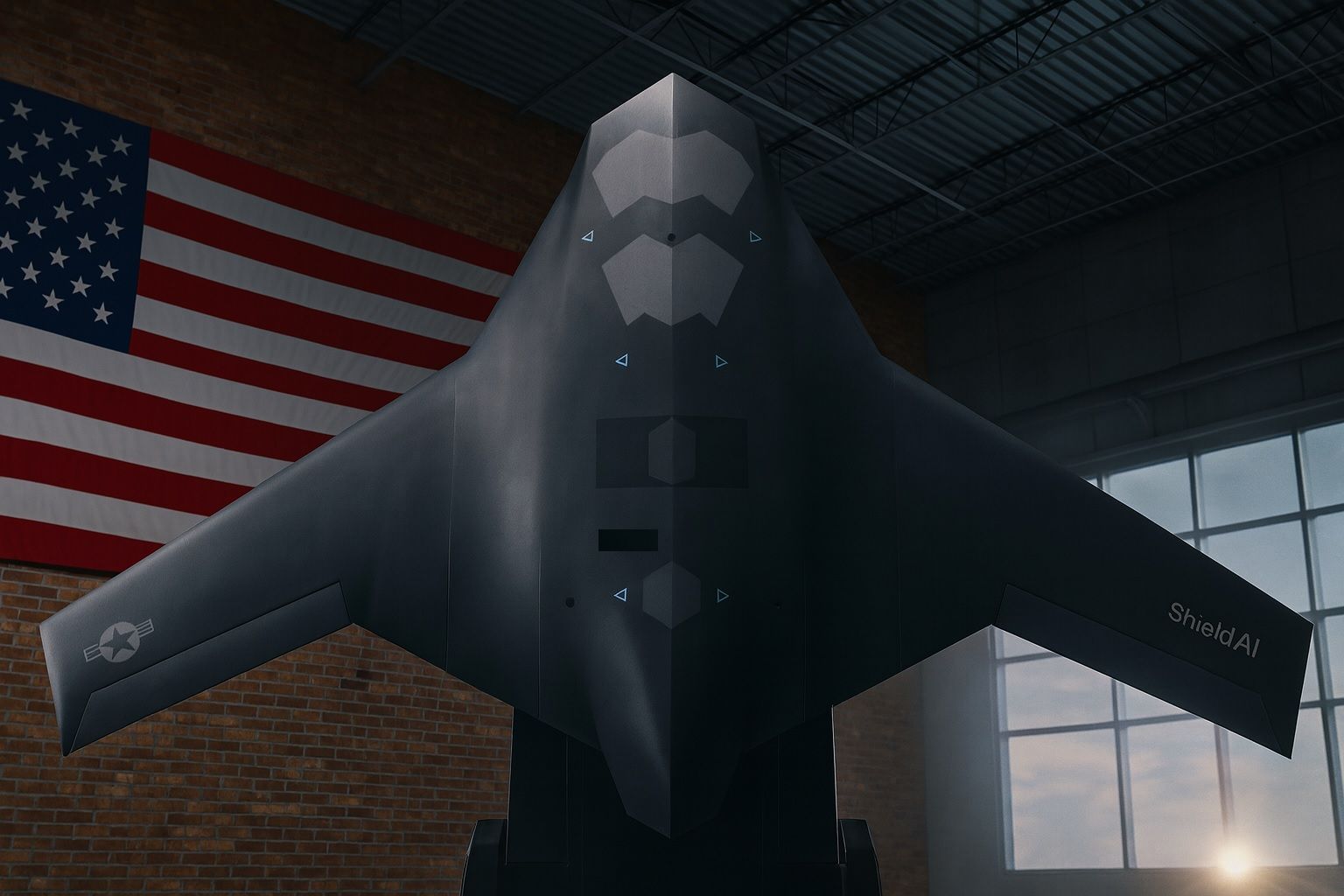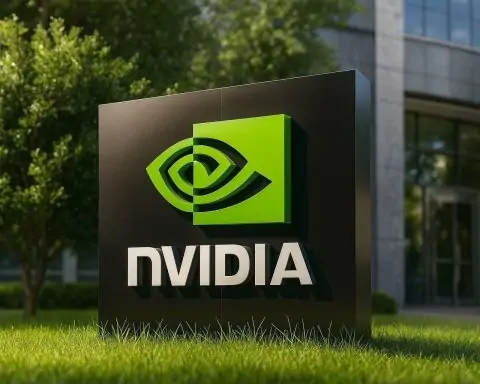- Innovative Jet: On Oct. 22, 2025, Shield AI unveiled the X-BAT – an AI-piloted, vertical-takeoff-and-landing (VTOL) fighter jet [1]. The jet is designed for contested environments, capable of flying solo or as a “loyal wingman” alongside manned fighters [2] [3].
- Key Specs: X-BAT soars to 50,000 ft altitude with a combat radius over 2,000 nautical miles while fully loaded [4] [5]. It launches and lands vertically from ships, islands or improvised sites (no runway needed) [6] [7]. Three X-BATs can fit in the deck space of one legacy fighter [8], and its stealthy “cranked-arrow” design minimizes radar signature [9].
- AI & Autonomy: The jet uses Shield AI’s Hivemind autonomy software, enabling it to navigate without GPS or constant comms. X-BAT can penetrate enemy airspace, plan its route on-the-fly around threats, and even identify targets, though final kill orders remain human-authorized [10]. Shield AI’s mission is “intelligent swarming” – deploying teams of autonomous drones under human oversight [11].
- Cost & Attritability: Shield AI says X-BAT will cost roughly $27 million each [12] – dramatically cheaper than a manned 5th-gen jet. The company claims a 10× improvement in cost-per-mission compared to legacy fighters like the F-35 [13] [14]. By being affordable and “attritable” (expendable in high-end combat), commanders can risk these drones in ways they might not risk billion-dollar manned jets [15] [16].
- Deterrence & Strategy: Co-founder Brandon Tseng calls X-BAT a “transformative” design, noting that “airpower without runways is the holy grail of deterrence.” [17] U.S. officials see it as a way to survive China’s missile-first-strike strategy: China has built a so-called A2/AD (Anti-Access/Area-Denial) “bubble” of long-range missiles (like the DF-21D/DF-26) aimed at destroying U.S. jets on the ground [18] [19]. By keeping jets off fixed runways and constantly on the move, X-BAT counters that threat.
- Autonomy Timeline: Shield AI expects first VTOL flight tests in 2026 and full X-BAT demonstrations by 2028 [20]. Combat-ready jets are envisioned by about 2029 [21]. The U.S. Air Force and Navy are evaluating such “Collaborative Combat Aircraft” (CCA) drones. Notably, Shield AI is already supplying its Hivemind AI for the Air Force’s CCA program [22].
China’s Runway-Busting Threat
U.S. analysts warn that China’s military doctrine emphasizes crippling U.S. airpower on the ground. The People’s Liberation Army has deployed thousands of long-range precision missiles (including anti-ship “carrier killer” DF-21D/DF-26 missiles) to hit U.S. carriers and Pacific airfields [23]. “They’ve basically said, ‘We’re not going to compete stealth-on-stealth in the air — we’ll target your aircraft before they even get off the ground,’” explains Armor Harris, Shield AI’s VP of Aircraft Engineering [24]. Indeed, modern air wars often begin by striking runways or airbases (Israel’s strike on Iran’s airfields, or Russian strikes on Ukrainian runways) to prevent jets from taking off. In this context, the U.S. fears that a Chinese first strike could ground much of its air fleet before a conflict even begins. X-BAT is designed specifically to counter that scenario by eliminating runways as a vulnerability.
X-BAT: Specs and Capabilities
Shield AI’s announcement paints X-BAT as a “Group 5” (i.e. fighter-size) stealth drone. It has a tailless, cranked-arrow wing planform said to be radar-evading [25]. Powered by a jet fighter engine (either a Pratt & Whitney F100 or GE F110, the same used on F-16/F-15 aircraft [26]), it is expected to be supersonic – the only such VTOL fighter in development [27] [28]. Range is 2,000+ nm with a full weapons load, giving it an impressive 1,000 nm combat radius [29]. This lets it strike distant targets from remote bases, ships or austere sites that have no runways.
Crucially, X-BAT launches and lands vertically. It uses a proven 3D thrust-vectoring nozzle for a “tail-sitter” landing [30], allowing takeoff/landing on small ships, trailers or cleared terrain. With a 39-ft wingspan and 26-ft length (roughly F-5 size), X-BAT is very compact [31]. In fact, as Shield AI notes, three X-BATs can fit in the deck footprint of one traditional fighter or helicopter [32], dramatically boosting sortie generation from limited space. Its payload can include air-to-air missiles (AIM-120 AMRAAMs, future long-range “Gunslinger” AAMs) and small standoff munitions, with some capability for external stores [33].
The jet’s avionics are built around Hivemind, Shield AI’s self-driving software. Hivemind-equipped X-BAT can operate in GPS- and communications-denied environments: on-board sensors and AI let it “read and react” to terrain and threats in real time [34]. In practice, this means X-BAT could navigate around radar or missile threats autonomously, without a human pilot or constant datalink. If new threats emerge, it can reroute, identify targets, and even request human permission to engage. Harris emphasizes that a human is always in the loop for lethal decisions [35], even if the aircraft itself flies and fights autonomously.
The jet is designed for versatility (“multirole”): strike, counter-air, electronic attack, ISR, and more. Shield AI calls it “platform agnostic,” meant to work with existing U.S. Air Force and Navy systems [36]. Its agility and VTOL capability align with the Air Force’s Agile Combat Employment concept – small units hopping between dispersed sites to avoid being parked on known runways [37]. In Brandon Tseng’s words: “Airpower without runways is the holy grail of deterrence. It gives our forces persistence, reach and survivability” [38].
Industry Reactions and Competition
Shield AI is one of several companies now racing to field next-gen drone fighters. The U.S. Air Force’s CCA (Collaborative Combat Aircraft) program has already awarded airframe deals to General Atomics and Anduril (for subsonic prototypes). The Navy is working its own CCA effort. Reuters notes Shield AI was tapped to provide the autonomy software for these programs [39]. In parallel, traditional primes are pitching new designs: Lockheed Martin recently unveiled a subsonic “Vectis” stealth drone and Sikorsky (Lockheed’s helicopter unit) showed a family of rotary-wing “Nomad” VTOL drones [40]. None of those can match X-BAT’s supersonic speed, however. Shield’s entry stands out by combining range (>2,000 nm), VTOL, stealth and fighter-like payload in one package [41].
Analysts have noted that the X-BAT announcement is still conceptual. Reuters points out Shield AI has not yet signed any defense contracts specifically for X-BAT [42]. Company officials say they plan first test flights in mid-2026 and full production readiness by 2028 [43]. In industry terms, this is an aggressive schedule, but within the timeframe for the Air Force’s Increment 2 CCA (future phases beyond prototype). Shield AI itself just raised a $240 million funding round in March (led by L3Harris and a16z) to back these developments [44]. A Bloomberg report cited by Reuters suggested the X-BAT program could cost ~$1 billion [45] – money that Shield will likely try to raise from investors or partners.
Experts in aerospace see X-BAT as evidence of a strategic shift. Armor Harris describes it as part of a “generational shift toward distributed airpower,” analogous to SpaceX replacing a few giant satellites with constellations of many small ones [46]. He predicts that in future wars, “unmanned systems will outnumber [manned] 10 to one or 20 to one” [47]. By flooding the sky with relatively cheap drones, the U.S. could restore deterrence: “X-BAT presents an asymmetric dilemma to an adversary like China,” Harris says. “They don’t know where it’s coming from, and the cost of countering it is high” [48]. In other words, even if China can shoot down one or two X-BATs, it would need enormous missile salvos to cover uncertainty – multiplying China’s own risks.
Financial and Market Context
The unveiling of advanced weapon tech often stirs defense and tech stocks. On Oct. 27, 2025, major U.S. defense equities traded near record levels. Northrop Grumman (NYSE: NOC), which makes B-21 bombers and other aircraft, opened around $605 [49]; analysts have raised its 12-month price target into the $680–$720 range (a Moderate Buy consensus) [50] [51]. Lockheed Martin (LMT), maker of the F-35, traded near $485 [52]. On Oct. 27 it was about $485.18, down slightly from $485.41 Friday [53]. Wall Street analysts peg LMT’s fair value around $520 (about +7% upside) [54], and the company just reported strong Q3 results (EPS $6.95 vs. $6.39 consensus). Meanwhile, RTX (formerly Raytheon Technologies), which makes missiles and engines, opened near $178.80 [55]; analysts have a Moderate Buy rating with an $175–$181 target [56].
Investors are also eyeing AI and semiconductors: NVIDIA (NVDA), the leading AI-chip maker, was at roughly $191 (up ~2.5%) on Oct. 27 [57]. The leap in NVDA reflects broad confidence that AI technologies (from training chips to autonomy software) will see soaring demand across industries – including defense. (Note: Shield AI itself is private and not traded, but its high-profile funding round and $2+ billion valuation have drawn attention to AI startups in national security [58] [59].)
Overall, analysts see a bullish long-term case for defense and tech stocks tied to these trends. Northrop’s consensus price target (~$642) is well above its current ~$606 [60], and RTX’s target (~$176) is roughly in line with its $179 price [61]. Even smaller primes like General Dynamics or Boeing have notable CCA or UAV programs (e.g. GD’s fighter wings) that could benefit. The U.S. government’s increasing defense budget – often justified by the China threat – underpins this optimism. However, any investor note of caution? Some experts remind that these new systems are not yet proven at scale. And a regulatory or geopolitical turn could temper enthusiasm: for now, though, sentiment is hot for anything involving “AI” and “autonomy in combat.”
Analyst and Expert Views
Industry experts applaud the innovation but stress realistic timelines. “Developing and testing a fighter-grade aircraft is hard,” notes one aerospace analyst. X-BAT’s 2026 test date and 2029 service entry are ambitious but not impossible given Silicon Valley backing. Armor Harris, who worked at SpaceX before joining Shield, signals confidence in the program: he emphasizes human oversight of the AI (“a human decision-maker” will vet all lethal acts [62]) to address ethical and safety concerns. This line may reassure skeptics of fully autonomous killers.
Defense thinkers also view X-BAT in strategic context. They note that if China’s A2/AD bubble is indeed aimed at “runway denial,” then forcing US jets into a swarm of mobile drones could restore strategic balance. Shield AI’s focus on small Pacific islands and ships [63] fits the Indo-Pacific theater. Allies like Australia, the UK and the Netherlands have also expressed interest in CCA concepts, meaning there could be foreign partners in development. TechStock² notes Shield AI is among the leading “AI Titan” companies globally [64], underlining how Silicon Valley practices (rapid prototyping, risk tolerance) are now seeping into combat aviation.
Forecast: In the near term, X-BAT is a concept on the drawing board. But if Shield AI meets its timeline, the jet could enter limited service by the end of the decade. By 2030, if X-BAT fleets deploy on U.S. carriers or island hubs, they would complicate any Chinese strike plan. Each X-BAT sortie would force an adversary to launch more missiles or fighters, increasing their costs. Some analysts predict that by the 2030s, the U.S. Air Force might operate dozens of autonomous fighters alongside traditional jets. If successful, Shield AI’s effort could usher a transformation in air warfare – as one executive put it, “the same thing [is] happening in air power” as happened in space [65], i.e. moving from a few expensive platforms to many cheaper ones.
However, defense experts caution that new vulnerabilities could emerge. Jamming, cyberattacks, or anti-drone tactics might offset some advantages. Moreover, the Pentagon will be watching for cost overruns: even though X-BAT is said to be “attritable,” building thousands of them for $27M each still requires huge procurement budgets. In Congress and industry, X-BAT is likely to fuel debate over how many drones versus manned fighters the U.S. can afford and trust.
In sum, Shield AI’s X-BAT has grabbed headlines as a bold response to China’s missile threat. It embodies the Pentagon’s push for “affordable mass” and could reshape air combat by the next decade [66] [67]. As experts and investors dissect this news, one thing is clear: the future of air warfare is increasingly blending cutting-edge AI with age-old concerns of strategy and deterrence.
Sources: Recent briefings and articles by Fox News [68] [69], Defense News [70] [71], Air & Space Forces Magazine [72] [73], Reuters [74] [75], and industry trackers (TechStock² [76], MarketBeat [77] [78], Investing.com [79]) were used to compile this report. These detail the X-BAT’s capabilities, strategic rationale, market reaction and expert commentary. Each piece of information is cited to its source.
References
1. www.defensenews.com, 2. www.defensenews.com, 3. ts2.tech, 4. www.foxnews.com, 5. www.airandspaceforces.com, 6. www.foxnews.com, 7. www.airandspaceforces.com, 8. www.foxnews.com, 9. www.airandspaceforces.com, 10. www.foxnews.com, 11. ts2.tech, 12. www.airandspaceforces.com, 13. www.foxnews.com, 14. www.defensenews.com, 15. www.foxnews.com, 16. www.airandspaceforces.com, 17. www.airandspaceforces.com, 18. www.foxnews.com, 19. www.foxnews.com, 20. www.reuters.com, 21. www.foxnews.com, 22. www.reuters.com, 23. www.foxnews.com, 24. www.foxnews.com, 25. www.airandspaceforces.com, 26. www.airandspaceforces.com, 27. www.foxnews.com, 28. www.airandspaceforces.com, 29. www.airandspaceforces.com, 30. www.airandspaceforces.com, 31. www.airandspaceforces.com, 32. www.foxnews.com, 33. www.airandspaceforces.com, 34. www.foxnews.com, 35. www.foxnews.com, 36. www.airandspaceforces.com, 37. www.airandspaceforces.com, 38. www.airandspaceforces.com, 39. www.reuters.com, 40. www.airandspaceforces.com, 41. www.airandspaceforces.com, 42. www.reuters.com, 43. www.reuters.com, 44. www.reuters.com, 45. www.reuters.com, 46. www.foxnews.com, 47. www.foxnews.com, 48. www.foxnews.com, 49. www.marketbeat.com, 50. www.marketbeat.com, 51. www.marketbeat.com, 52. www.investing.com, 53. www.investing.com, 54. www.investing.com, 55. www.marketbeat.com, 56. www.marketbeat.com, 57. www.investing.com, 58. ts2.tech, 59. ts2.tech, 60. www.marketbeat.com, 61. www.marketbeat.com, 62. www.foxnews.com, 63. www.foxnews.com, 64. ts2.tech, 65. www.foxnews.com, 66. www.defensenews.com, 67. www.foxnews.com, 68. www.foxnews.com, 69. www.foxnews.com, 70. www.defensenews.com, 71. www.defensenews.com, 72. www.airandspaceforces.com, 73. www.airandspaceforces.com, 74. www.reuters.com, 75. www.reuters.com, 76. ts2.tech, 77. www.investing.com, 78. www.marketbeat.com, 79. www.investing.com









